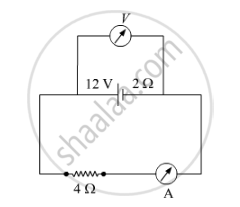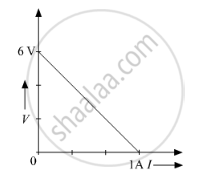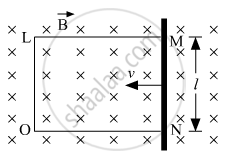Advertisements
Advertisements
प्रश्न
A battery of emf 12 V and internal resistance 2 Ω is connected to a 4 Ω resistor as shown in the figure.
(a) Show that a voltmeter when placed across the cell and across the resistor, in turn, gives the same reading.
(b) To record the voltage and the current in the circuit, why is voltmeter placed in parallel and ammeter in series in the circuit?

उत्तर
(i) According to the definition of terminal potential difference,
E = V + Ir
`=>V=E-Ir`
E = 12 V, r = 2 Ω
V = 12 – 2I
When the voltmeter is connected across the cell.
`I=12/(4+2)=2A`
V1 = 12 – 2 (2) = 8 V
When the voltmeter is connected across the resistor.
V2 = IR
= 2 × 4 = 8 V
V1 = V2
Hence, from the above relation we can see that when voltmeter placed across the cell and across the resistor, gives the same reading
(ii) Voltmeter has very high resistance to ensure that it's connection does not alter the flow of current in the circuit. We connect it in parallel and we also know that current chooses only the low resistance path. Hence, it is connected in parallel to the load across which potential difference is to be measured.
Ammeter measures value of current flowing through the circuit so it should be connected in the series. Ammeter has very low resistance to ensure that all the current flows through it. Thus, it gives a correct reading of the current when connected in series.
APPEARS IN
संबंधित प्रश्न
The plot of the variation of potential difference across a combination of three identical cells in series, versus current is shown below. What is the emf and internal resistance of each cell ?

Two identical cells of emf 1.5 V each joined in parallel, supply energy to an external circuit consisting of two resistances of 7 Ω each joined in parallel. A very high resistance voltmeter reads the terminal voltage of cells to be 1.4 V. Calculate the internal resistance of each cell.
Nichrome and copper wires of same length and same radius are connected in series. Current I is passed through them. Which wire gets heated up more? Justify your answer.
Plot a graph showing variation of voltage vs the current drawn from the cell. How can one get information from this plot about the emf of the cell and its internal resistance?
A rectangular conductor LMNO is placed in a uniform magnetic field of 0.5 T. The field is directed perpendicular to the plane of the conductor. When the arm MN of length of 20 cm is moved towards left with a velocity of 10 ms−1, calculate the emf induced in the arm. Given the resistance of the arm to be 5 Ω (assuming that other arms are of negligible resistance) find the value of the current in the arm.

Find the emf of the battery shown in the figure:

Answer the following question.
What is the end error in a meter bridge? How is it overcome? The resistances in the two arms of the metre bridge are R = Ω and S respectively. When the resistance S is shunted with equal resistance, the new balance length found to be 1.5 l1, where l2 is the initial balancing length. calculate the value of s.

A cell having an emf E and internal resistance r is connected across a variable external resistance R. As the resistance R is increased, the plot of potential difference V across R is given by ______.
The internal resistance of a cell is the resistance of ______
